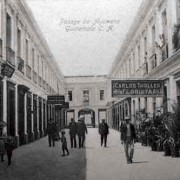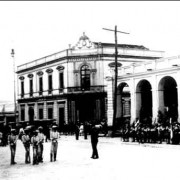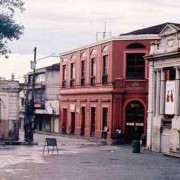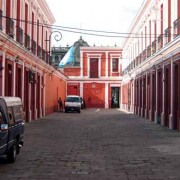The Time Tunnels of Zone One
Read—or walk —your way through 22 minutes of time travel in Guatemala’s historic center
The yen to envision a familiar place in an earlier era is universal. In the sixties, it found expression in the campy sci-fi serial The Time Tunnel, in which two scientists are sporked through historical crossings in which the supporting roles—from Alexander the Great onward—conveniently speak English.A more credible time trek can be taken in downtown Guatemala in only 22 minutes. Long before climate-controlled malls in Minneapolis, there were, and still are, Zone One’s pasajes. Exploring them affords a cobwebby peek at el Centro as it was when the pasajes were echo-chambers for dawn reveilles of machine-gun rat-tatting, martial doggerel and coups d’etat.
Four fascinating pasajes abut the Plaza de Armas, that square enclosed by the National Palace, National Library and National Cathedral. The fourth edge is home to banks, a vegetarian diner, camera and shoe shops, an arched colonnade, and two of these time tunnels.
Begin on 7th Avenida, a half block south of the plaza. Facing the entrance to Edificio del Centro (downtown’s tallest building) is the aperture of Tunnel 1, the rust-red Real del Parque. Go in.
This least historical tunnel is included as a foil to the others and as a glimpse, not of what downtown was, but what it aspires to. Elsewhere in the city are new, sprawling counterpoints to this mall, though none has its garish, high-density charm.
Real del Parque dates from the still-cooling surface of the past century. When the 1996 Peace Accords were signed, it was just another drab commercial box. But today you can take in three floors of artsy-tartsy commercialism. Scarf some caramel corn, window shop, buy a knick-knack. Go up to the third floor to look down on the traffic. Time becomes a dimension that will stretch as you tour the other tunnels.This tunnel leads outside, to bustling 8th Calle. Turn right, go two-and-a-half blocks. When you reach Telas Líder, a cavernous old yardage mart, cross the street.
With all the clutter, you could almost miss Pasaje Savoy—Tunnel 2. But once in, you are standing before a big-screen clunker Motorola broadcasting The Time Tunnel. Its regression of fluorescent lights recalls the shiny ribs of the old TV prop. All that is missing is for the two time travelers to corporealize.
Return to the present by exiting Savoy on 7th Calle. Go left for half a block, then right for 10 meters, then left again at the La Tirada building. To your left, as you walk, is the Mercado Central, an underground comb of tunnels on five split levels—all “dug” after the 1976 earthquake. On its above-ground parking lot, there once stood the spectacular neo-classic pre-quake mercado.
Walk another block toward the looming National Palace. Cut across the Plaza de Armas, just to the left of the huge fountain, toward the colonnade opposite the Palace. Cross the street and seek out the jail-cell door that looks locked. It is not —push through it. You have just sneaked in through the back of Tunnel 3, Pasaje Aycinena, which was once, incredibly, a mansion belonging to one of the republic’s founding families. By the 1930s it was what some historians call Guatemala’s first centro commercial—an honor claimed by another Time Tunnel that is a literal stone’s throw away.When you re-emerge into the light—this tunnel has no roof—look back. You see the door you came through and the outline of two others, one arched and wide enough for a carriage. The space between them is now filled by a cubby-hole enterprise.
Before you exit Pasaje Aycinena through the arch on 9th calle, look up and marvel at the contrast of the Pasaje’s ornamented vaults with Edificio del Centro’s utilitarian angles. Back on the sidewalk outside, you are again in the 21st century. But turn right and walk 25 meters to Tunnel 4, to sample yet another slice of the past.
The aperture to Pasaje Rubio is a wormhole flagged by glass-walled galaxies of jewelry. Now enter what other historians call Guatemala’s first centro comercial. Its founder, Señor Rubio—no one recalls his first name—built it as a place for the elite to shop and dine. Until 2008, its liver-spotted complexion and patchy floor made it seem old for its 80 years; today, the well-to-do (excepting coin hounds) rarely shop here. But despite the wrinkles in its original ambience, it remains a time-strolling venue. Except for an appliance dealer, every store retains some of its original character.
A coin-and-stamp store is a miniature museum and one of only three numismatic retailers in town. It is one of a dozen locales exhibiting everything from taxidermy to antique knives and dolls. Almost next door is where the late Policarpio Mejía, “King of Luck,”
once reigned. Owing to self-promotion and customer superstition, Policarpio and his heirs are periodically celebrated in newspapers as a source of winning lottery tickets. For years, people from the provinces went out of their way to visit the king. There is a belief that Pasaje Rubio itself is lucky, so the lottery in every permutation has become its chief commodity.
A certain Frenchman visited 45 years ago—but not to see Policarpio. He had read a mention of Pasaje Rubio in a yellowing pre-World-War-II architectural journal and—as a photographer—was intrigued. But Rubio was already in decay, and the man left in a huff without taking a single photo. Why was he blind to its charms? Perhaps from his jading acquaintance with early malls in rundown parts of Paris. But in Guatemala, nothing compares with Rubio, then or now.
Betancourt, a dimly-lit stationer near the asymmetric fork in Rubio’s middle, resembles an outside storefront; nobody knew, when it opened, how centro commercial stores were supposed to look. The place is layered with the strata of time and the ghosts of Guatemalan intellectuals who once browsed the shelves.
“Rubio,” explains Betancourt’s proprietress, “was a living ruin for decades because Mr. Rubio sold out to the individual shopkeepers. We couldn’t agree on anything. When the place needed painting, we couldn’t agree on the color. The floors and windows needed fixing, too. But when we passed the hat, some merchants didn’t chip in. Others squabbled over what their share should be.”
Next to Betancourt, you could buy a book from Edgar Jahnig. His hole-in-the-wall nook was a pasaje within a pasaje, wide enough for just one person at a time. His family immigrated from Germany when he was a boy, and Jacobo Arbenz was President when Edgar opened for business in 1951. Over the years, he became a beacon for Germanic bibliophiles, and every third bargain book on his sagging shelves was in German. A steel portón now seals Don Edgar’s memory; he died last year.
There is more to Rubio than its ossified locales. As you stroll through, look not just left and right, but up at the dilapidated grandeur of its second and third floors, and you will feel you are in another era. Take a stairway to the upper levels, which are mostly small apartments. From behind the spindled railings you can look down on Rubio´s movie-set vibrancy and wonder: “if these walls could talk …”And so they can—to mice. On the other tine of Rubio’s fork was a wedding accessory shop, Novias Camelia. Over the decades, for a few hours each day, a gifted raconteuse showed up to work her day job. The Rubio owes its private literary heritage to the fertile imagination of María del Carmen Escobar, most famously in 49 Cents of Happiness, a novel narrated by a mouse. The joys and heartbreaks it chronicles are thinly fictionalized, giving us a snapshot that is gossipy and whimsical on the one hand, but instructive on the other.
In Rubio’s core, near the fork, is its most time-proof artifact: Guatemala’s oldest continuously operated restaurant, El Portal, which—like María Escobar—is a whole other story.
In 2008, Rubio was remodeled and repainted for the first time that anyone remembers. But it is only a makeover; the place is still timeless, still bathed in gold, somewhere you can touch the city’s soul.



